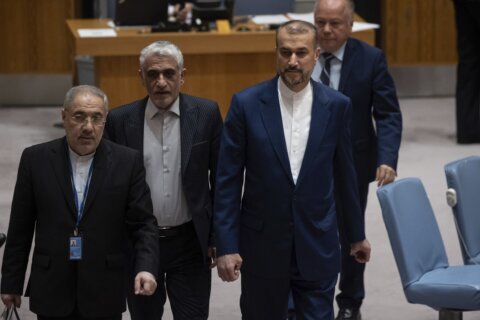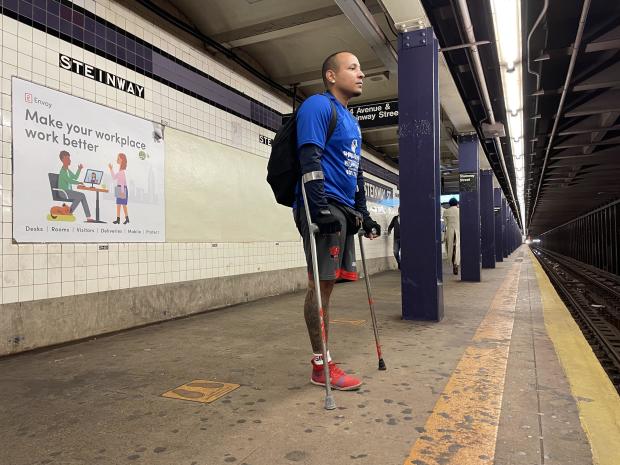 Juan Vargas uses the New York subway system to get to work at a fast food restaurant in Brooklyn, as well as soccer fields across the city.
Juan Vargas uses the New York subway system to get to work at a fast food restaurant in Brooklyn, as well as soccer fields across the city.
Camilo Montoya-Galvez
New York — To get to his overnight job flipping burgers and making french fries at a well-known fast food restaurant in Brooklyn, Juan Vargas, 38, leaves the room he shares with another man at a homeless shelter at 9 p.m. on most weekdays to catch the subway.
On Saturday mornings, when he’s off from work, Vargas takes the train for more than an hour to Long Island to play with the New York affiliate of the American Amputee Soccer Association, an emerging league for players with limb differences. On Fridays, his other day off, Vargas tries to find pick-up soccer games, using the subway system to get around the city and crutches to get from station to station.
“It’s my passion,” Vargas said on a recent Friday on the M train, en route to an indoor soccer complex in Queens, where he played with other Venezuelan migrants who had also recently arrived in New York after crossing the U.S.-Mexico border. Vargas, however, was the only amputee, having lost his entire left leg in 2018.
With a soccer cleat on his right foot, Vargas uses his crutches to move around the small indoor fields, pacing his runs given the extra effort he has to exert with his arms. He quickly showed he could play at the same level as the other Venezuelan newcomers, some of whom had murmured earlier that they did not want to play too aggressively given his disability. He scored his team’s first goal.
Vargas said the challenge of playing with non-disabled men or riding the subway late at night as an amputee and a recently arrived migrant does not come close to the perils he faced during a 23-day journey across seven Latin American countries to reach the U.S. earlier this year.
Vargas noted he slept on the street in Mexico and Central America, and was detained by U.S. border agents before being released. But he said the most difficult part of the trek was crossing the roadless and mountainous Panamanian jungle known as the Darién Gap, where some migrants have perished.
Other migrants, Vargas said, warned him not to cross the jungle, saying the days-long trek was perilous enough for those without disabilities — let alone an amputee. After all, crossing the jungle requires traversing several rivers, grueling mountains and muddy terrain on foot.
But Vargas said he was determined to get to the U.S. His willingness to see out the journey, he said, provided a dose of inspiration to the other migrants traveling with him during an otherwise grim experience.
“Those nine days felt like an eternity. But it was either getting out of the jungle or dying,” Vargas said, noting that some migrants and indigenous Panamanians helped him along the way.
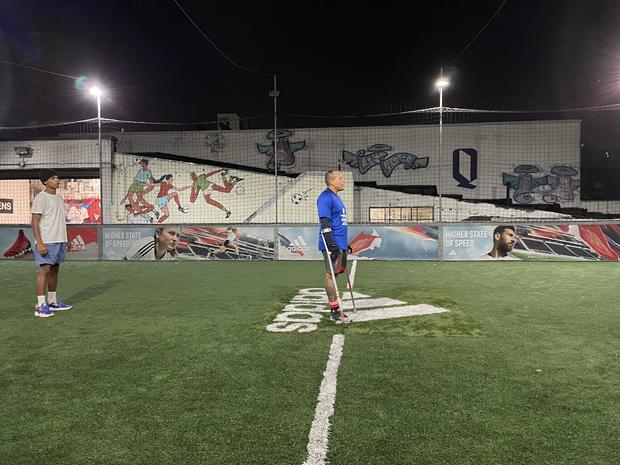 Juan Vargas during a match at a soccer complex in Queens.
Juan Vargas during a match at a soccer complex in Queens.
Camilo Montoya-Galvez
Driven by economic desperation and hopes of more welcoming U.S. immigration policies under President Biden, tens of thousands of Venezuelans like Vargas have left Venezuela or other South American nations over the past year en route to the U.S. border, where officials have reported record levels of migrant arrivals.
In fiscal year 2022, a 12-month span that ended on Sept. 30, nearly 190,000 Venezuelans were processed by U.S. border officials, making Venezuela the fifth-largest source of migration to the U.S.-Mexico border, according to federal statistics. This year alone, approximately 150,000 Venezuelans have crossed the Darién Gap, a record high, Panamanian government data show.
The record arrivals of Venezuelans along the U.S. southern border are part of a massive exodus from Venezuela, which has seen 7 million people flee to other countries to escape authoritarian rule and economic calamity in the largest refugee crisis ever recorded in the Western Hemisphere.
The number of Venezuelan migrants crossing the U.S. border and the Darién jungle has declined since the Biden administration started expelling Venezuelans to Mexico in mid-October. But more than 20,000 Venezuelans entered U.S. border custody that month, and thousands are estimated to be waiting in Mexico for the approaching termination of pandemic-related U.S. border restrictions on Dec. 21.
“I chose to live”
Inside the indoor soccer complex in Queens, the other Venezulean migrants treated Vargas as an equal during a series of boisterous matches. Many of them said they were also living in shelters that New York officials set up to accommodate more than 27,000 migrants who arrived to the city this year, oftentimes after being bused there by state or local officials in Texas.
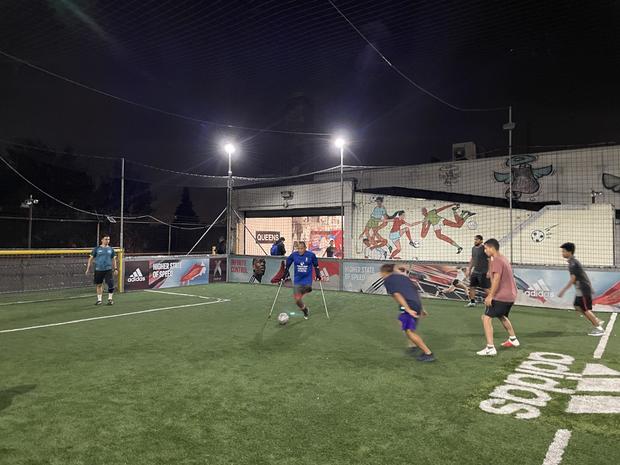 Juan Vargas plays soccer with other Venezuelan migrants, many of whom are also living in homeless shelters or repurposed hotels across New York City.
Juan Vargas plays soccer with other Venezuelan migrants, many of whom are also living in homeless shelters or repurposed hotels across New York City.
Camilo Montoya-Galvez
When the games ended, Vargas and the other players asked each other what parts of Venezuela they hailed from. Several of the migrants told Vargas they admired his willingness to play with them.
That sentiment was echoed by a player from another group who told Vargas, “God bless you, man.” Vargas embraced the stranger, recognizing the respect he was projecting.
Vargas said he left Venezuela in 2017 because of the country’s economic collapse. After some time in Colombia and Ecuador, he settled in Peru, where his wife and daughter were later able to join him. That’s where Vargas said his life was upended during an otherwise ordinary day in 2018.
Vargas said a truck ran him over on his way to work in Lima. He was hospitalized and slipped into a coma. The doctors, Vargas recounted, said he only had two choices: lose his left leg or die. “I chose to live,” he said.
While the amputation was devastating and required months of recovery, Juan said it ultimately allowed him to find two new passions, in weight lifting and amputee soccer. Despite being from Venezuela, Juan said he was able to become part of the first national Peruvian soccer team for amputees. He represented the team in international tournaments, becoming its captain.
But Vargas said his career in amputee soccer did not allow him to provide for his family. Finding other jobs in Peru, he said, was difficult given his condition. He left in early August, flying to Colombia to start his weeks-long trek across Central America and Mexico. His wife and daughter stayed behind.
 Juan Vargas kicks the ball during a training session by the Peruvian Amputee Football team on December 17, 2021 in Lima, Peru.
Juan Vargas kicks the ball during a training session by the Peruvian Amputee Football team on December 17, 2021 in Lima, Peru.
Getty Images
After reaching the Texas border, Vargas was detained and later released by U.S. border agents, who instructed him to check in with federal immigration officials at his respective destination. The U.S. has relied on this procedure to process tens of thousands of migrants, including Venezuelans, whose home countries reject U.S. deportations. Volunteers at a Texas shelter helped Vargas get on a flight to New York.
While glad to be in the states, Vargas said he misses his wife and daughter, who recently turned 6. He also faces an uncertain legal predicament.
Vargas has an appointment with Immigration and Customs Enforcement on Nov. 25, 2024, and has yet to receive a notice to appear in immigration court, where he can begin the process of applying for asylum.
But even if gets the chance to seek asylum, Vargas will likely face a years-long wait due to a massive backlog of pending cases. He will also face an uphill battle in meeting the criteria for asylum, which require applicants to show they fled persecution based on their race, nationality, religion, politics or membership in a social group.
Still, Vargas said he’s grateful to have a job and a roof over his head — and he’s placing all his hopes in soccer. He said his dream is to one day represent the U.S. in amputee soccer tournaments or to coach a team.
“The American dream was created a long time ago,” Vargas said. “But you have to work for it to make it yours.”
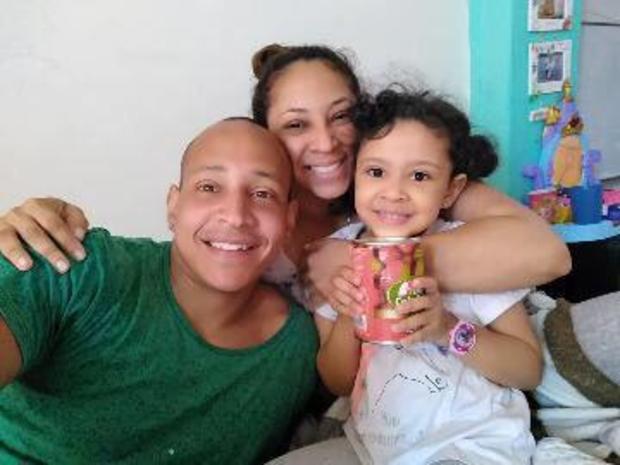 Juan Vargas poses for a photo with his wife and their daughter in Peru.
Juan Vargas poses for a photo with his wife and their daughter in Peru.
Juan Vargas
Carlos Ayala, 33, a fellow amputee soccer player, said Vargas has already shown in training sessions and games that he has the potential to play for the U.S. Ayala, who lost part of right leg during the 2001 earthquake in El Salvador, has represented the national U.S. amputee team, including in a World Cup in Turkey this year.
Ayala said Vargas joined the New York affiliate of the American Amputee Soccer Association after he reached out to the national amputee team’s captain. For the past few weekends, Ayala has been picking up Vargas at the Amityville train station and driving him to an indoor soccer facility in Kings Park where the team trains.
“He’s established himself here with us very quickly. He has good control of the ball, and hits it well,” Ayala said. “If he continues like that, he will get called up to the national team.”
“I tell him, ‘You’re here through a miracle,'” Ayala said, referring to the trek Vargas undertook to get to the U.S.

